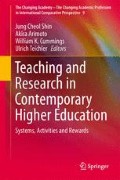Abstract
Since the World War II, academic work in the USA came to be structured by institutional type and academic field. Faculty in research universities spent their time in different ways than those at baccalaureate colleges and faculty in the sciences or professional fields in very different ways from those in the humanities and social sciences. As academic work and careers evolve, we are now seeing increasing diversification within institutional types and academic fields—primarily on the bases of type of appointment (regular, full-time, vs. part-time and limited term). Teaching and research are increasingly being undertaken by different kinds of faculty on different kinds of appointments rather than as an integrated set of responsibilities of every faculty member. Within the context of this increasing role specialization as between teaching and research, two trends seem clear: the teaching emphasis of faculty work has grown, while the resources and actual faculty effort devoted to research have slightly declined. Some of that may be attributable to the rise of full-time nontenure eligible, limited contract faculty with more highly specialized roles. More American faculty are now engaged in either teaching or research than at any time in the last half century, and it is the “pure” teacher contingent that is growing. Moreover, the actual publication productivity of American academics has declined over the past 15 years (1992–2007)—that is, fewer resources and less time invested have resulted in less productivity by the conventional standard of scholarly publications.
Access this chapter
Tax calculation will be finalised at checkout
Purchases are for personal use only
Notes
- 1.
In Finkelstein et al. The New Academic Generation (Johns Hopkins, 1998), it was shown that new trends that were barely discernible in aggregate data became striking when that same data was disaggregated by year of entry to the academic profession, that is, that new developments clearly affecting new recruits might be largely hidden by aggregate data.
- 2.
This unexpected (at least in terms of direction) teaching differential may reflect the disproportionate number of contract faculty in this earlier period with research as their principal activity, especially at the research universities. Such faculty typically teach much less (Schuster and Finkelstein 2006).
References
Baldwin, R., & Chronister, J. (2001). Teaching without tenure. Baltimore: Johns Hopkins University Press.
Boyer, E. (1990). Scholarship reconsidered: Priorities of the professoriate. Princeton: Carnegie Foundation.
Carnegie Foundation for the Advancement of Teaching. Original 1992 weighted datafile.
CAP [The Changing Academic Profession]. (2009)/ Original U.S. weighted datafile.
Clark, B. (1987). Academic life: Small worlds, little worlds. Princeton: Carnegie Foundation.
Cross, J., & Goldenberg, E. (2009). Off track profs: Non-tenured teachers in higher education. Cambridge: MIT Press.
Finkelstein, M. (1984). The American academic profession: A synthesis of social scientific inquiry since world war II. Columbus: The Ohio State University Press.
Finkelstein, M., Seal, R., & Schuster, J. (1998). The new academic generation: A profession in transformation. Baltimore: Johns Hopkins University Press.
Gappa, J., & Leslie, D. (1993). The invisible faculty. San Francisco: Jossey-Bass.
Kezar, A., & Sam, C. (2010). Understanding the new majority: Contingent faculty in higher education. ASHE higher education reports. San Francisco: Jossey-Bass.
Schuster, J., & Finkelstein, M. (2006). The American faculty; the restructuring of academic work and careers. Baltimore: Johns Hopkins University Press.
Slaughter, S., & Rhoades, G. (2004). Academic capitalism and the new economy: Markets, state, and higher education. Baltimore: Johns Hopkins University Press.
Wildavsky, B. (2010). The great brain race: How global universities are reshaping the world. Princeton: Princeton University Press.
Author information
Authors and Affiliations
Corresponding author
Editor information
Editors and Affiliations
Rights and permissions
Copyright information
© 2014 Springer Science+Business Media Dordrecht
About this chapter
Cite this chapter
Finkelstein, M. (2014). The Balance Between Teaching and Research in the Work Life of American Academics. In: Shin, J., Arimoto, A., Cummings, W., Teichler, U. (eds) Teaching and Research in Contemporary Higher Education. The Changing Academy – The Changing Academic Profession in International Comparative Perspective, vol 9. Springer, Dordrecht. https://doi.org/10.1007/978-94-007-6830-7_16
Download citation
DOI: https://doi.org/10.1007/978-94-007-6830-7_16
Published:
Publisher Name: Springer, Dordrecht
Print ISBN: 978-94-007-6829-1
Online ISBN: 978-94-007-6830-7
eBook Packages: Humanities, Social Sciences and LawEducation (R0)

